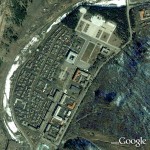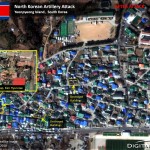On June 5, 1937, the Dong-A Ilbo, then as now one of the leading Korean dailies, recounted an incident that took place in the small township of Pochonbo on the Korean border with China. The newspaper reported that a band of Korean “communist bandits” from China attacked the Japanese police in this city, took it over, burned some Japanese agencies and then withdrew safely.
This was sensational: the years of guerrilla activities in Korea proper were long over, and since the early 1910s the Korean guerrillas only operated overseas. A daring raid of the “communist bandits” (whom many Koreans in those days considered “Korean freedom fighters”) came as a complete surprise. The raid was led by a young commander whose name – Kim Il -sung – thus became widely known across the country.
Kim Il-sung, then still known under his birth name of Kim Sǒng-ju, spent his childhood in China where his family moved in around 1920, fleeing both economic insecurity and political persecution. Kim Il-sung’s father, Kim Hyǒng-jik, a missionary-educated school teacher and herbalist, was a lifelong nationalist sympathizer, even though his political role was subsequently blown out of proportion completely by North Korean propaganda. Kim Il-sung was still a middle school student when he lost his father in 1926, not an unusual fate in the era when the average male life expectancy was less than 30. His mother did not live much longer.
When Kim Il-sung died in 1994, he was clearly a tyrant, in all probability, the worst tyrant in Korean history. Arguably, he and his henchmen killed more Koreans than any foreign invader. Hence, there is a great temptation to see him as evil incarnate. However, history is never that simple.
It is hard to find traces of an emerging tyrant in the Kim Il-sung of the 1920s and 1930s. As we have mentioned above, he was a high school graduate and, back in the Manchuria of 1930, this was a remarkably high level of educational achievement. In those days a high school graduate was roughly as common as a Ph.D. holder is nowadays. His education opened a way to earthly success for the young man, but he chose another path and joined a guerrilla band in the Chinese communist forces.
We’ll probably never know exactly the motivation behind this fateful decision, but one cannot doubt that these reasons must have been lofty and altruistic, based on a mixture of nationalist and communist idealism. There were many people like him, but he was lucky to survive and, later, was unlucky to be sucked ― almost against his own will ― into the brutal world of the violent Cold War politics. In this world he got absolute power, and this power corrupted him (as well many other survivors of the communist guerrilla resistance in Manchuria).
However, in the 1930s those young Korean communists, together with Korean nationalists and, of course, together with the Chinese of all political persuasions challenged the might of Imperial Japan which in 1931 stepped up its aggression against China.
In 1931 Japanese forces invaded and occupied the three north eastern provinces of China. They proclaimed this territory’s “independence” from China and established the puppet state of Manchuguo (literally, “the state of Manchuria”). The last Emperor of the Qing Dynasty, which ruled China from 1644-1911, became the titular monarch of this state, but all control over its activity remained in the hands of the Japanese military – sufficient to say that the commander Japanese forces in the area was by default an “ambassador” to the Manchuguo court and “adviser” to the puppet emperor.
This turn of events outraged everybody. Chinese nationalists could not stand the encroachment of Japan into Chinese lands. Korean nationalists were ready to fight the Japanese everywhere. The communists of both nations were eager to take a stand against the most aggressive imperialist power in the region. In the years 1931-1932, thousands of people of all nationalities and persuasions joined the guerrilla bands that appeared in the mountains in great numbers.
According to official North Korean propaganda, Kim Il -sung headed the Korean People’s Revolutionary Army, which was said to have been created by him, from the beginning. Obviously, this version has nothing to do with reality. North Korean propaganda has always tried to present Kim Il-sung first of all as a national Korean leader and thus downplay his early contacts with China and the Soviet Union. Actually, no Korean People’s Revolutionary Army ever existed. Kim Il-sung was a soldier with the Chinese communist forces.
Around 1935, Kim Sông-ju adopted a nom-de-guerre that would resonate through history: he became Kim Il-sung. The young guerrilla showed himself to be a good, able, and brave soldier, so his career progressed fast. In 1936, the 24-year-old fighter was the commander of the Sixth Division, which included a few hundred fighters and operated in Manchuria near the Korean border. By that time he was probably the best known ethnic Korean commander operating in the area.
At dawn on June 4, 1937, Kim Il-sung led some 150-200 guerrillas to the city of Pochonbo. This small-scale but daring operation was the highest point in Kim’s decade-long career as a guerrilla commander.
In the late 1930s Japanese forces and their local collaborators prevailed, and the guerrilla resistance in Manchuria was gradually wiped out. In late 1940, the few survivors, including Kim Il-sung and his wife, found asylum across the border, in the USSR.
In the summer of 1942, the Soviet command decided to establish a special unit which would include these guerrillas. Most of them were Chinese, but Koreans constituted a significant minority among them. This unit was known as the 88th independent brigade, and its base was located in the village of Viatsk (Viatskoe) near Khabarovsk. This is where Kim Il-sung’s wife gave birth to a son who was given a Russian name, Yura, a vernacular form of Yuri (now he is better known under his Korean name of Kim Jong-il, which was then seldom used).
Korean guerrillas, many of whom had once fought under the command of Kim Il-sung, served in Kim’s first battalion, while three other battalions of the brigade consisted of ethnic Chinese.
It seems as if Kim Il-sung was satisfied with his new position. At least, his superiors had no complaints about him. During their sojourn in Viatsk, Kim Il Sung and his wife Kim Chông-suk had two more children: a son named Shura (short for Alexander) and a daughter. The children’s Russian names might indicate that at the time a return to Korea did not look very plausible for Kim. According to a fellow officer, Kim Il-sung saw his future quite clearly: service in the Red Army, study at a military academy, then the command of a regiment or, with a stroke of luck, even a division. One can easily imagine how Kim Il-sung, an old retired colonel or even major general of the Soviet Army, might have died somewhere in Moscow, while his son Yuri would have worked in some Moscow research centre and, quite possibly, in the late 1980s would have participated with gusto in the pro-democracy rallies…
However, history took another turn. When in 1945 the Soviets drove the Japanese away from northern Korea, they decided to create a pro-Soviet regime in this part of the country. Kim Il-sung, young, charismatic and seemingly loyal to the Soviet interests, but also known in Korea because of his earlier guerrilla exploits, was seen as the best candidate to head such a regime.
This decision started a chain of events which were mostly tragic and sometimes shameful. In order to justify his right to rule, Kim Il-sung had no choice but to remake his Manchurian struggle into a heroic myth of huge proportions. He had to portray himself as the sole leader of the entire resistance movement, and also present this resistance as a force which liberated the country almost single-handedly (the Russians ― let alone Americans ― were edited out of the official history completely).
Clearly, these are lies or, at least, gross exaggerations. However, we should not come to another extreme conclusion and deny any contributions of the Korean communist guerrillas in Manchuria. Yes, the survivors of this struggle eventually played a tragic role in Korean history. But this does not mean that they were not heroes back in the 1930s when they waged their desperate struggle against the mighty enemy. In history, the line between villains and heroes, so obvious and clear-cut in action movies, is far more difficult to draw in real life and real history.



